 |
The Saint of the Day
St. Hildegard von Bingen, September 17
Prof. Plinio Corrêa de Oliveira
Biographical selection:
St. Hildegard was born at Bermersheim in the Diocese of Mainz in the year 1098, the 10th and last child of noble and virtuous parents. When she was eight years old, recognizing her deep piety and unusual spiritual gifts, they took her to the Convent of Mount St. Disibodenberg and placed her under the direction of the Abbess Jutta, daughter of Count Stephan of Spanheim.
From age 8 to 15, Hildegard had many visions, of which she spoke with simplicity to her companions, who were amazed, like all who became aware of them. They wondered what could be the source of the visions.

Ruins of the Convent of St. Disibodenberg
|
Hildegard herself explained that she saw things interiorly in her soul related to the external things that were happening around her, which she saw with the eyes of her body. When she realized this did not happen to others, she became fearful and no longer commented on her visions. In her conversations, however, she would refer to things yet to come and other thoughts that seemed extraordinary to those who heard her speak. This supernatural gift she had throughout her whole life.
She was 40 years old when she heard a voice from Heaven ordering her to write down everything she saw. For a long time, she resisted, not from obstinacy, but from humility and distrust. At age 42 she saw Heaven opening up and a luminous flame pierced her forehead, heart and chest, penetrating it with gentle warmth. At that moment she received an understanding of the Psalms, the Gospels and the other books of the Old and New Testaments, so that she could explain their meaning even though she did not know Latin.
Still fearful to write her visions, she fell ill. Finally, she confided her concerns to Abbess Jutta, who in turn informed the spiritual director of the Convent. After questioning Hildegard, he ordered her to write down her visions, which she started to do. Almost immediately she rose from her bed, cured.
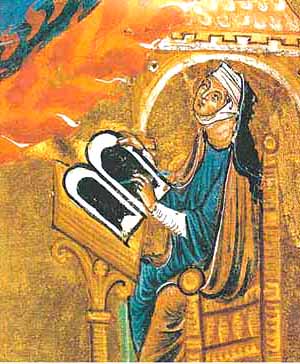
St. Hildegard of Bingen receiving revelations
|
The spiritual director went to Mayence to show Hildegard's writings to the Archbishop and high members of the clergy. After studying them, the Archbishop decided to consult with the Pope himself on the matter.
First, Pope Eugenius III sent Alberon, Bishop of Verdun, to the Convent to examine Hildegard's doctrine. She answered with great simplicity to all the questions he asked her. After receiving the Bishop's report, the Pope ordered the Scivias to be brought to him. Taking them in hand, he read it in a loud voice to the Prelates assembled at the Synod of Trier (1147-1148). He also related everything that had been told to him by the emissaries he had sent, and all present gave thanks to God.
St. Bernard, who was present, then asked the Pope to confirm and approve this great grace conceded by God to the Church in his pontificate. Also, he advised that Hildegard be instructed to relate to the Pope what was revealed to her through the Holy Spirit regarding his pontificate.
She announced a difficult epoch ahead, whose first signs were already being manifested. These were her symbolic words:
"The valleys [the people] will complain about the mountains [their superiors], and the mountains will fall upon the valleys, because their subjects [the people] will no longer have fear of God. They are eager to climb to the summit of the mountains to accuse the prelates instead of accusing themselves of their own sins.
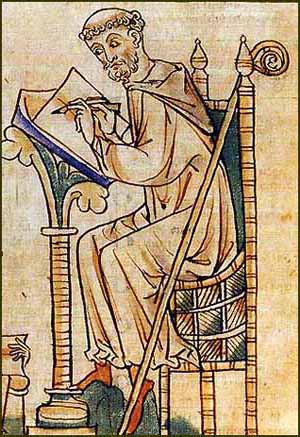
St. Bernard wrote to St. Hildegard encouraging her to persevere
|
"The valleys say it is right that they should be higher. Moved by envy they denigrate all that the superiors do.
"The valleys are like fools who instead of cleaning their dirty clothing do nothing more than look at the color of their neighbor's dress.
"The mountains themselves, instead of rising continuously in intimate communications with God so that they are increasingly transformed into the light of the world, become careless and obscured.
"And you, the Great Pastor and Vicar of Christ, should seek the light for the mountains and constrain the valleys. Give precepts to the lords and discipline to the subjects.
"The Sovereign Judge tells you that you should condemn and send away the inopportune and wicked in fear that, to your great confusion, they should interfere with your affairs. But be compassionate to sinners, public and private, for God does not disdain the wounds and sorrows of those who fear Him."
Hildegard made predictions and gave similar counsels to Bishops and Barons who wrote to her from all parts to consult her. In her time, Hildegard had an influence among women similar to that of that of Bernard among men. She had numerous revelations about the works of God from the creation of the world to the defeat of the Antichrist.
She died on September 17, 1179 on Sunday night at age 80.
Comments of Prof. Plinio:
We see that the life of St. Hildegard was a kind of continuous, permanent and palpable miracle. Everything about her is admirable and miraculous.
She was given a prophecy about the Revolution that was beginning to manifest itself in her times. It seems that she was also entrusted with a prophecy about many aspects of the Revolution until the end of time. We will see that this Saint, who has a special connection to the R-CR, actually made prophecies related to this theme. And in this sense it is an important confirmation of it.
Regarding her life, I point out how the hagiographers of the past never failed to mention when a saint was born of illustrious and virtuous parents, as Hildegard was.
Hildegard was just a child when she entered the Benedictine Convent, and had Blessed Jutta to form her from age 8 onward. Today it is no longer permitted to introduce children into a religious order at such a young age. But Hildegard flourished marvelously in her Convent.
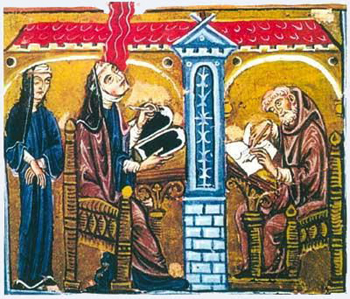
The Holy Spirit illuminates St. Hildegard, who dictates her vision to a scribe
|
Her visions started when she was very young and she thought everyone saw the same things. So, she commented on them naturally and with all simplicity. Such simplicity and naturalness was already proof of the authenticity of her visions.
Her enlightenment regarding the Scriptures was obviously a gift of the Holy Spirit. We know that at that time the Bible was always written in Latin. Even though she did not understand Latin well, she would explain the texts that were read to her. This is a most remarkable miracle that was continuous and palpable, an external fact that anyone could confirm as true. It would be as if a person who did not know the Arabic language were presented with an Arab text. Without understanding the words, he would interpret the text. If this is not a miracle, I do not know what is.
Approval of the Pope and St. Bernard
Let us stop to consider the revelations she wrote in the work Scivias sent to Pope Eugenius. We see that after a prudent investigation, the Pope took a favorable stance and thought it worthwhile to read them aloud to the gathered assembly of Cardinals and Bishops.
"He read them in a loud voice" - and thus we come to a scene that deserves to be represented in an illumination or painting.
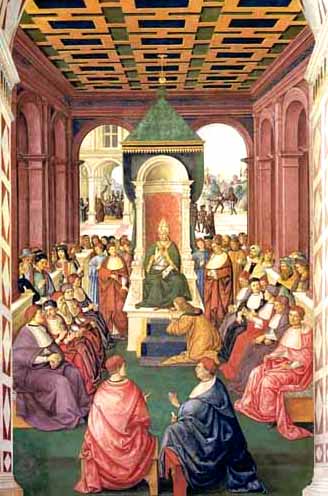
A papal meeting with Cardinal and Bishops
|
You can imagine a hall of that time, with the Pope in the center on one of those stone thrones, sometimes connected to the wall itself; then the Cardinals sitting erect - not leaning or resting on one side or the other of their chairs - in a line of chairs on either side of the throne. So the Pope starts reading the revelations of St. Hildegard to this assembly - the Cardinals and the Archbishop of Mayence with all the clergy of Trier watching. It is a colorful and extraordinarily picturesque scene.
Imagine the reactions of those listening, "Thanks be to God! How good is our Redeemer! Praised be the Blessed Virgin Mary!" A chorus of praise! But you will see there is something even better: St. Bernard is present. What more can be said? He was, among other things, the author of the Salve Regina and the Memorare, the preacher of the 2nd Crusade and the Saint who gave the Templars their rule, the destroyer of Abelard.
Suddenly the hall is filled with the loud, powerful, holy and mellifluous voice of St. Bernard; the assembly trembles with expectation. With the presence of St. Bernard, everything is illuminated and transformed. This great Saint also testifies that he knows the holy nun Hildegard, since he visited her and had a very good impression of her.
And, he announces, he wrote a letter to her afterwards to congratulate her for the graces she received and to exhort her to remain true to herself. The great Saint first is moved by a wave of admiration. But afterwards comes a
movement of fear, the consideration that this earth is a valley of tears, that human misery is always present. And this prudent fear raises some questions: Will this marvel endure, or will it fall?
So that great and vigilant warrior, knowing human misery, wrote to Hildegard to exhort her to perseverance. One who is standing, said St. Paul, should take care not to fall. So this great Saint warns Hildegard to be cautious, to watch and pray so as not to fall into temptation. This is a correct understanding of humility.
The beginning of the Revolution
In the letter Hildegard wrote to Pope Eugenius, she warned him of a difficult time ahead, whose first signs were beginning to appear. It was the Revolution that was sprouting.
She wrote: "The valleys [the people] will complain about the mountains [the superiors], and the mountains will fall upon the valleys, because the subjects [that is, the valleys] will no longer have fear of God. They are eager to climb to the summit of the mountains to accuse the prelates instead of accusing themselves of their own sins."
It should be noted that the word "prelate" in that time referred not only to ecclesiastics, but also high personages in the temporal sphere. St. Thomas Aquinas speaks various times of "prelates," referring to important persons in the Church or the State. We see that the people - the valleys - were envious of these personages in the Church and State and were criticizing them for their faults, without correcting their own. It is very easy to blame others and ignore our own faults.
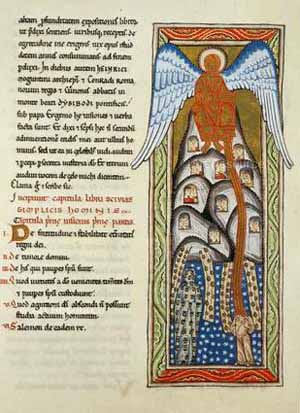
In the work Scivias, above, St. Hildegard warns the Pope about the beginnig of the Revolution
|
She writes, "The valleys say it is right that they should be higher. They denigrate all that the superiors do from envy."
We recall that a main characteristic of the Revolution is hatred for superiority. It is no longer hatred for a particular superior, but hatred of superiority as such. Superiority should no longer exist. What is good is equality as such.
She writes: "The valleys are like fools who instead of cleaning their dirty clothing do nothing more than look at the color of their neighbor's dress." This means, the people were not paying attention to their own souls in the state of mortal sin.
"As for the mountain" - that is, the nobles, high clergy and even high bourgeoisie "instead of rising continuously in intimate communications with God so that they are increasingly transformed into the light of the world, they are careless and become obscured."
Here you see the beautiful notion of the role of the nobility and the clergy. It is to have continuous communications with God to increasingly radiate the light of God - both in the spiritual and temporal spheres. Thus they are like a light at the top of the mountain that should illuminate the whole world. When they do not do this, relaxing their communication with God, they become darkened, no longer radiating the light that they should. And then darkness and confusion reign in the lower levels.
So, there was an envious people, but the departure point of this process was the position of the nobility and clergy who became cold toward God and let darkness fill the lower parts of society. And in a just and majestic chastisement, God allowed those lower parts of society, taken with envy, to overthrow those above them. How logical this is! How it shows the grandeur of the economy of Providence through History! Here you see the sanctity of Hildegard.
She writes, "And you, the Great Pastor and Vicar of Christ, should seek light for the mountains and constrain the valleys. Give precepts to the lords and discipline to the subjects."
See the curious task she assigned the Pope: He should seek light for the mountains, and constrain the valleys. He should tell those who are revolted to obey. But he should tell the authorities that they should turn toward the light. This is exactly the opposite from the progressivist tactic. The latter is to turn the mountains toward darkness and incite the valleys to revolt. It is impressive how counter-revolutionary her counsel was.
She continues: "The Sovereign Judge tells you that you should condemn and send away the inopportune and wicked in fear that, to your great confusion, they should interfere with your affairs."
Here she reveals something about the Pope's life. He was mixing with tyrants, favoring persons who tyrannized the people. Only if you know something of the History of that era can you understand this.
It is my impression that the Chastisement predicted in Fatima may be also mentioned in the work of this prophetess of the Revolution. You see here a person whose life was filled with miracles, continuous and indisputable miracles. On the other hand, she is a prophetic figure who saw the beginning of the Revolution and other prophecies regarding the course of the Revolution may also well be in her prophecies. It is a hint for our future research.


  | | Prof. Plinio Corrêa de Oliveira | |
The Saint of the Day features highlights from the lives of saints based on comments made by the late Prof. Plinio Corrêa de Oliveira. Following the example of St. John Bosco who used to make similar talks for the boys of his College, each evening it was Prof. Plinio’s custom to make a short commentary on the lives of the next day’s saint in a meeting for youth in order to encourage them in the practice of virtue and love for the Catholic Church. TIA thought that its readers could profit from these valuable commentaries.
The texts of both the biographical data and the comments come from personal notes taken by Atila S. Guimarães from 1964 to 1995. Given the fact that the source is a personal notebook, it is possible that at times the biographic notes transcribed here will not rigorously follow the original text read by Prof. Plinio. The commentaries have also been adapted and translated for TIA’s site.
|
Saint of the Day | Home | Books | CDs | Search | Contact Us | Donate

© 2002- Tradition in Action, Inc. All Rights Reserved
|
 |

|